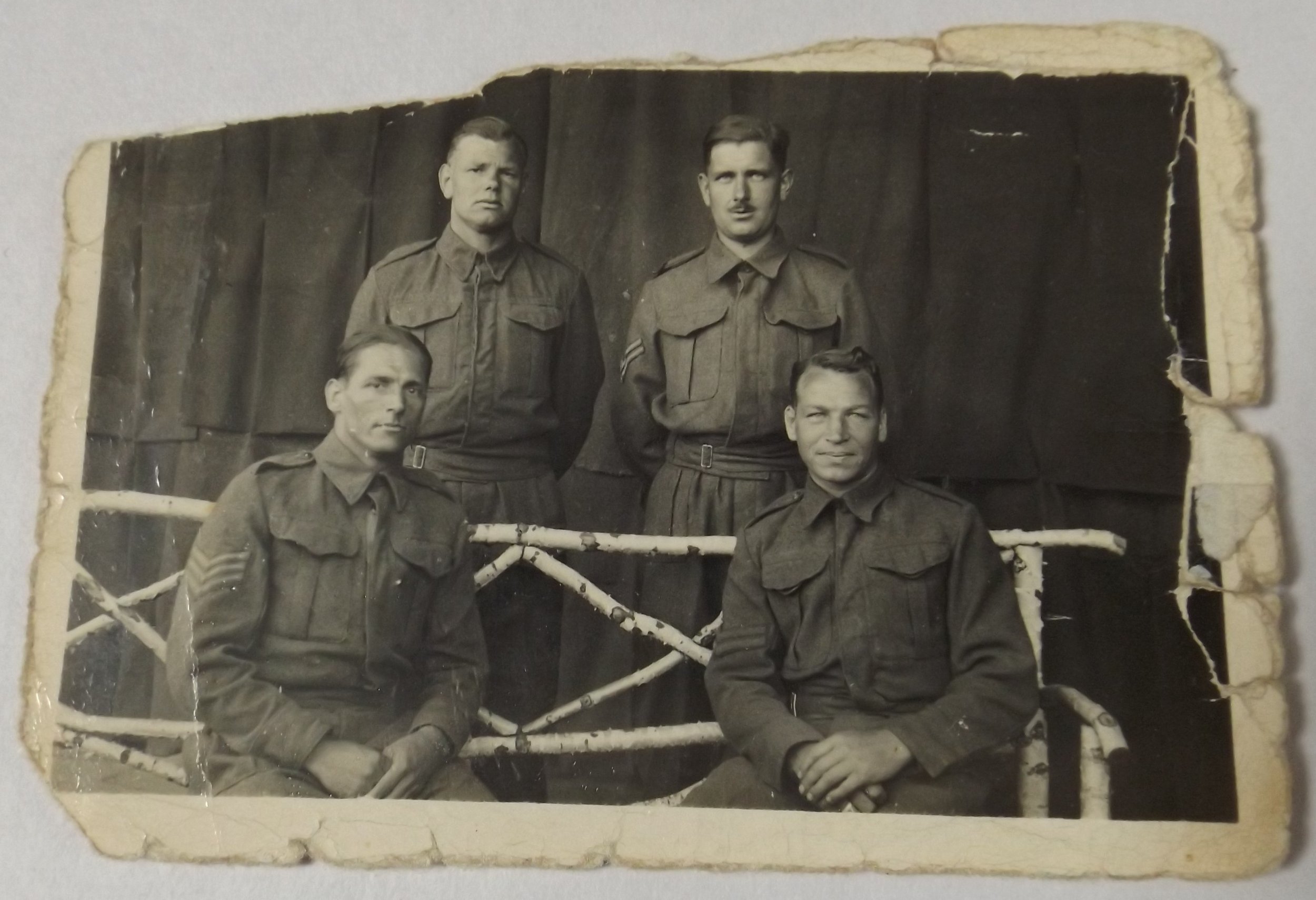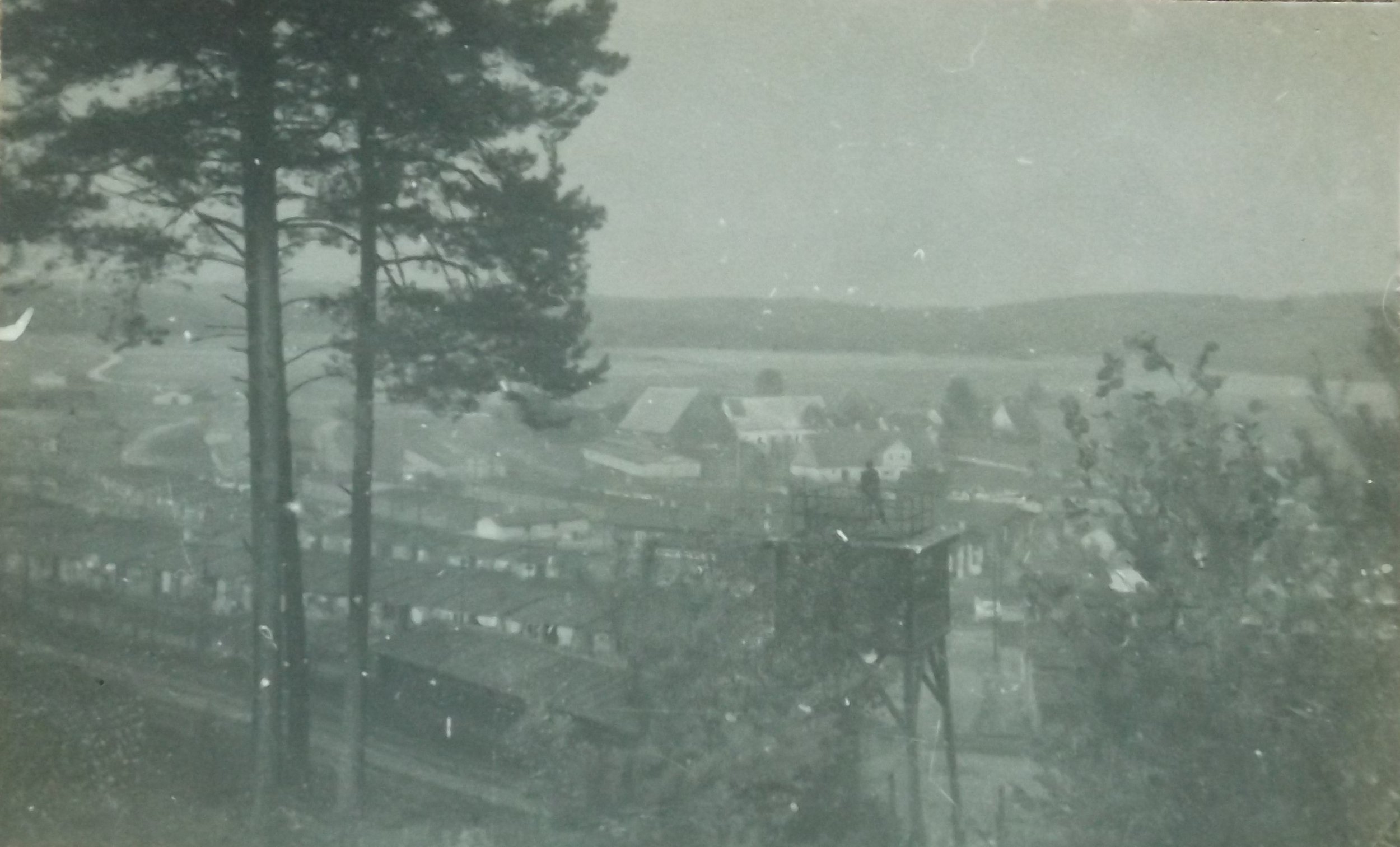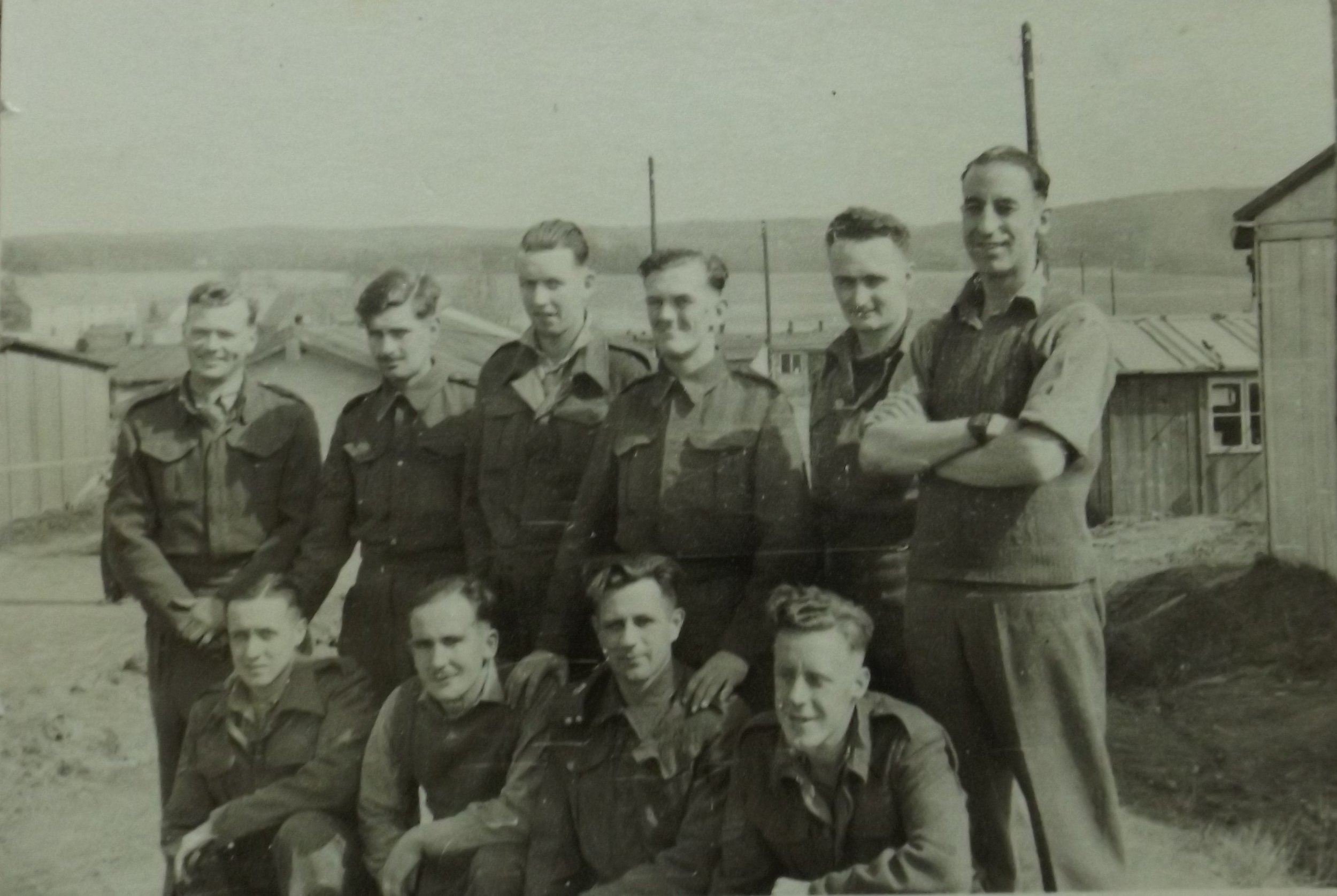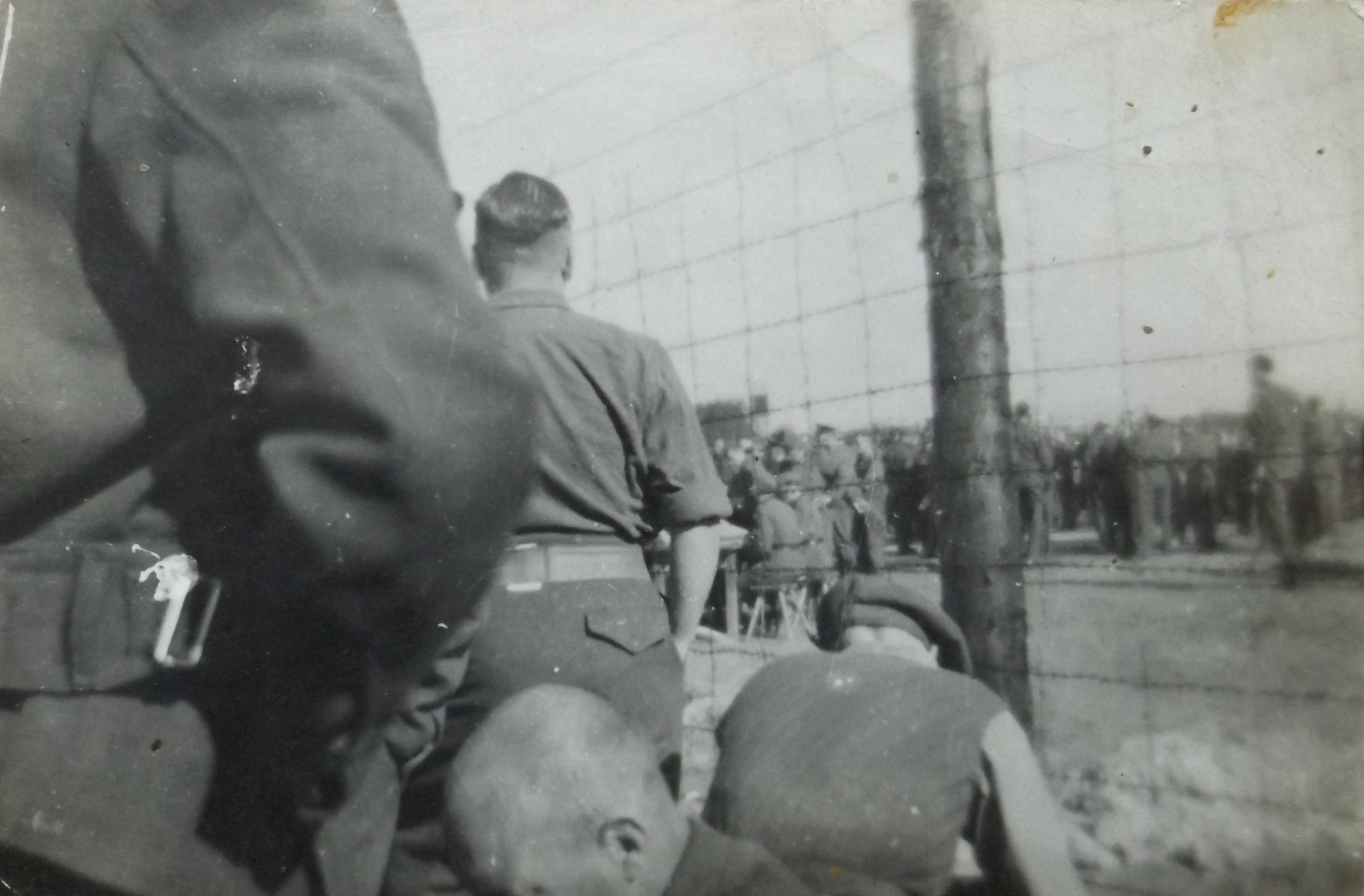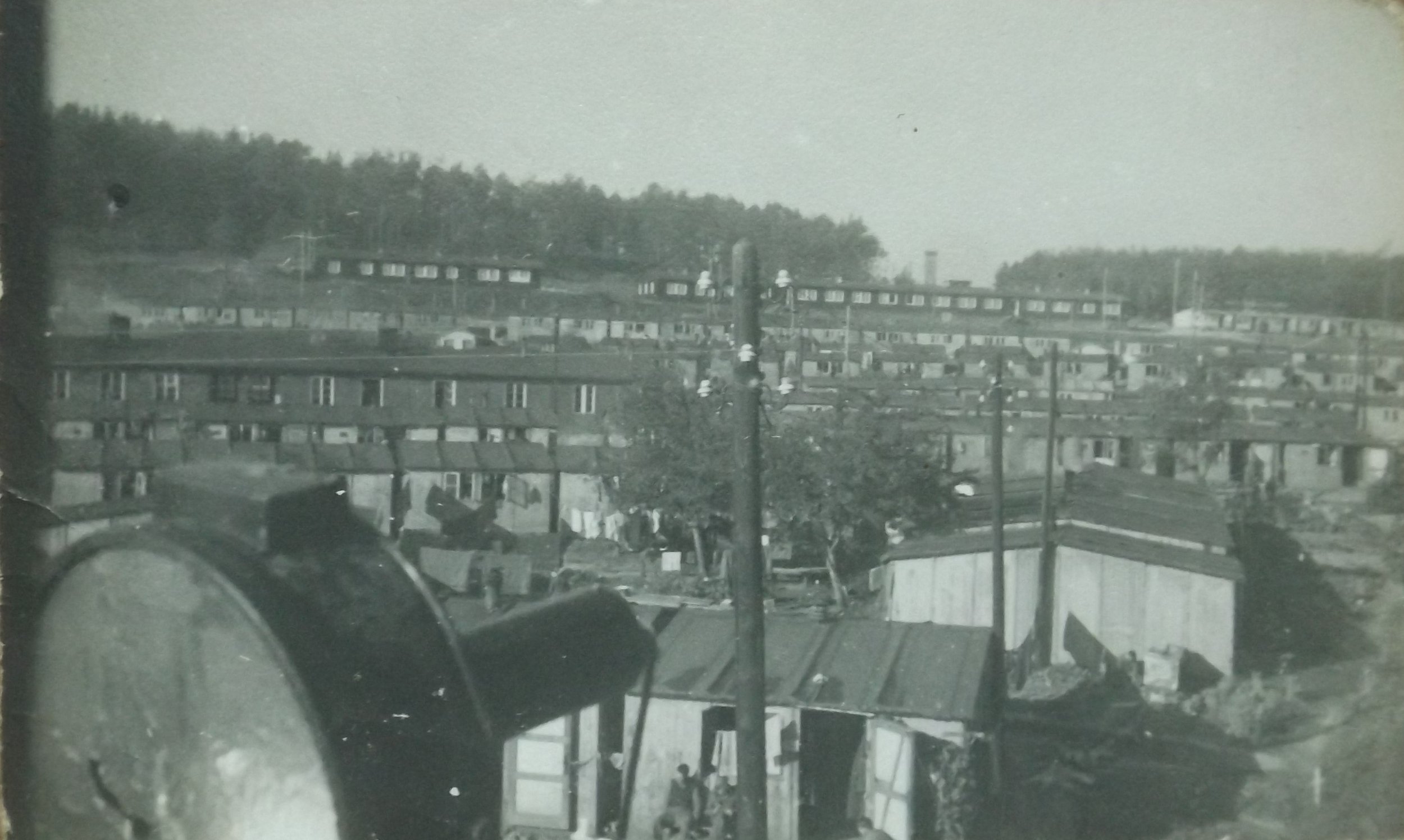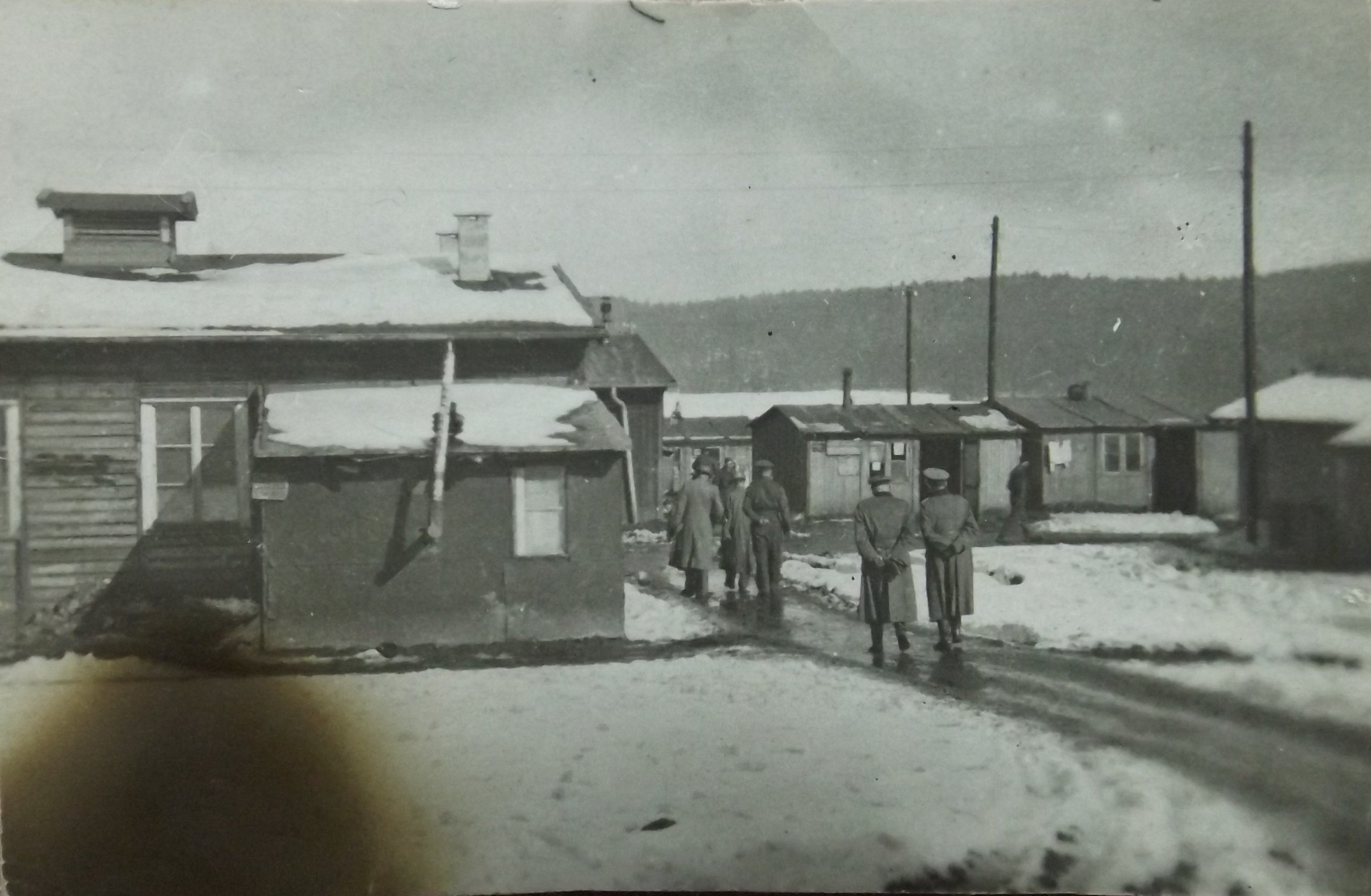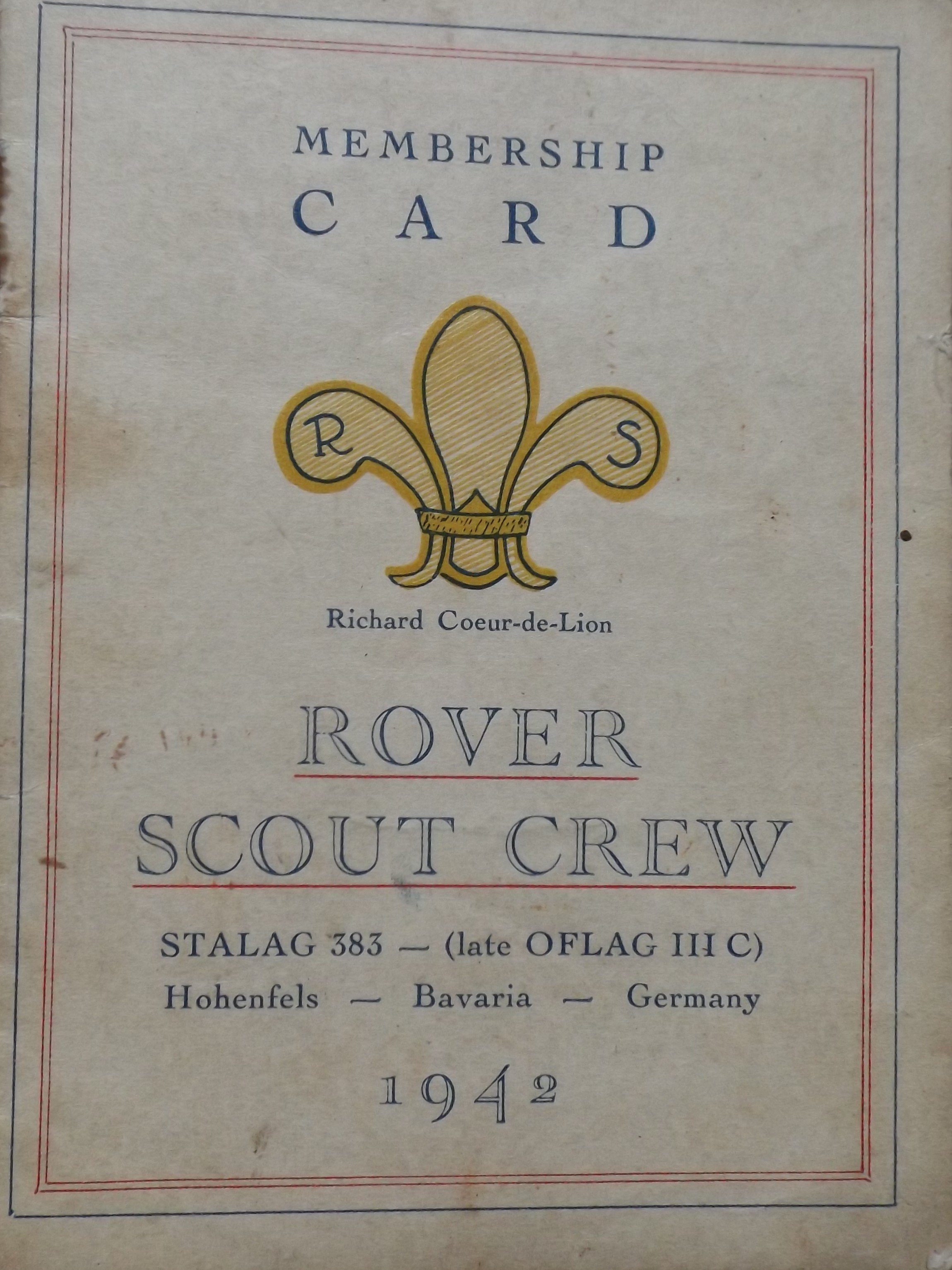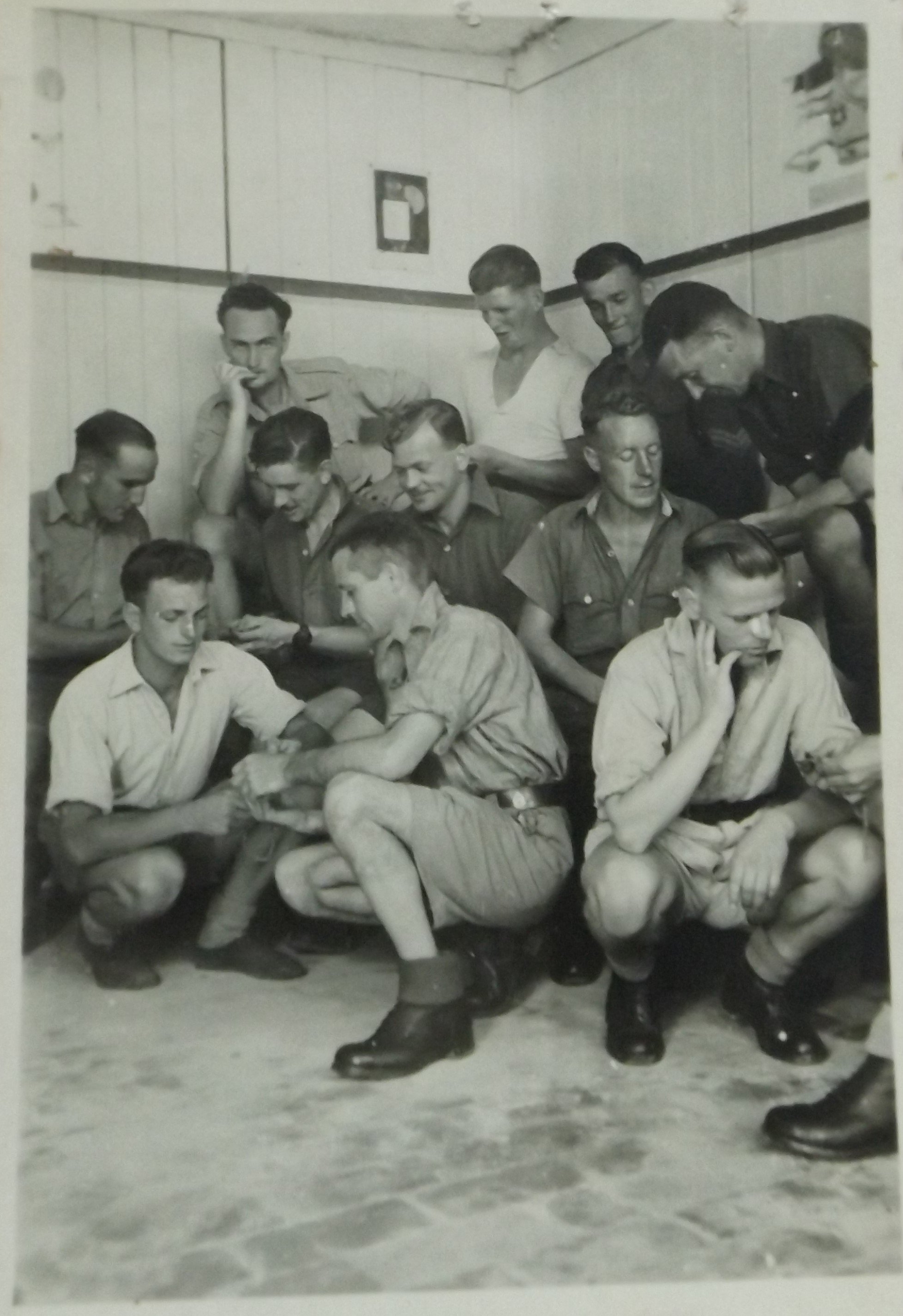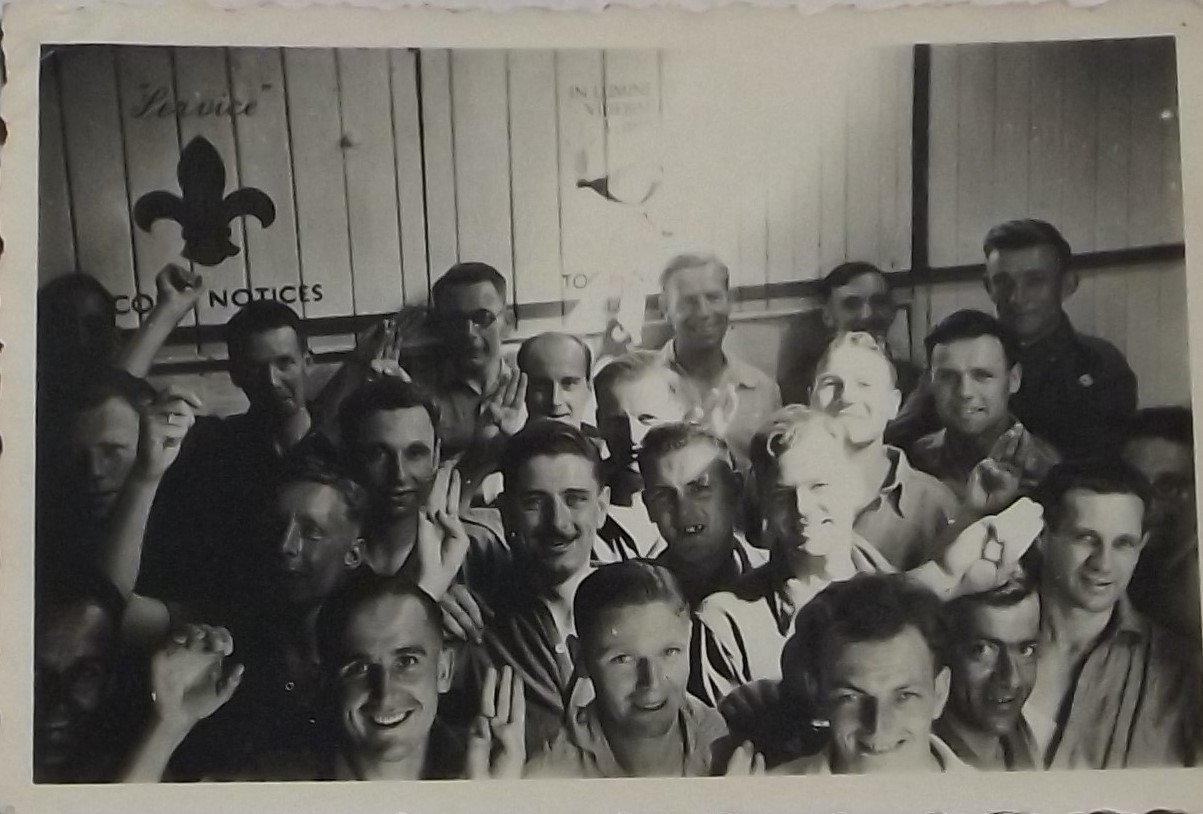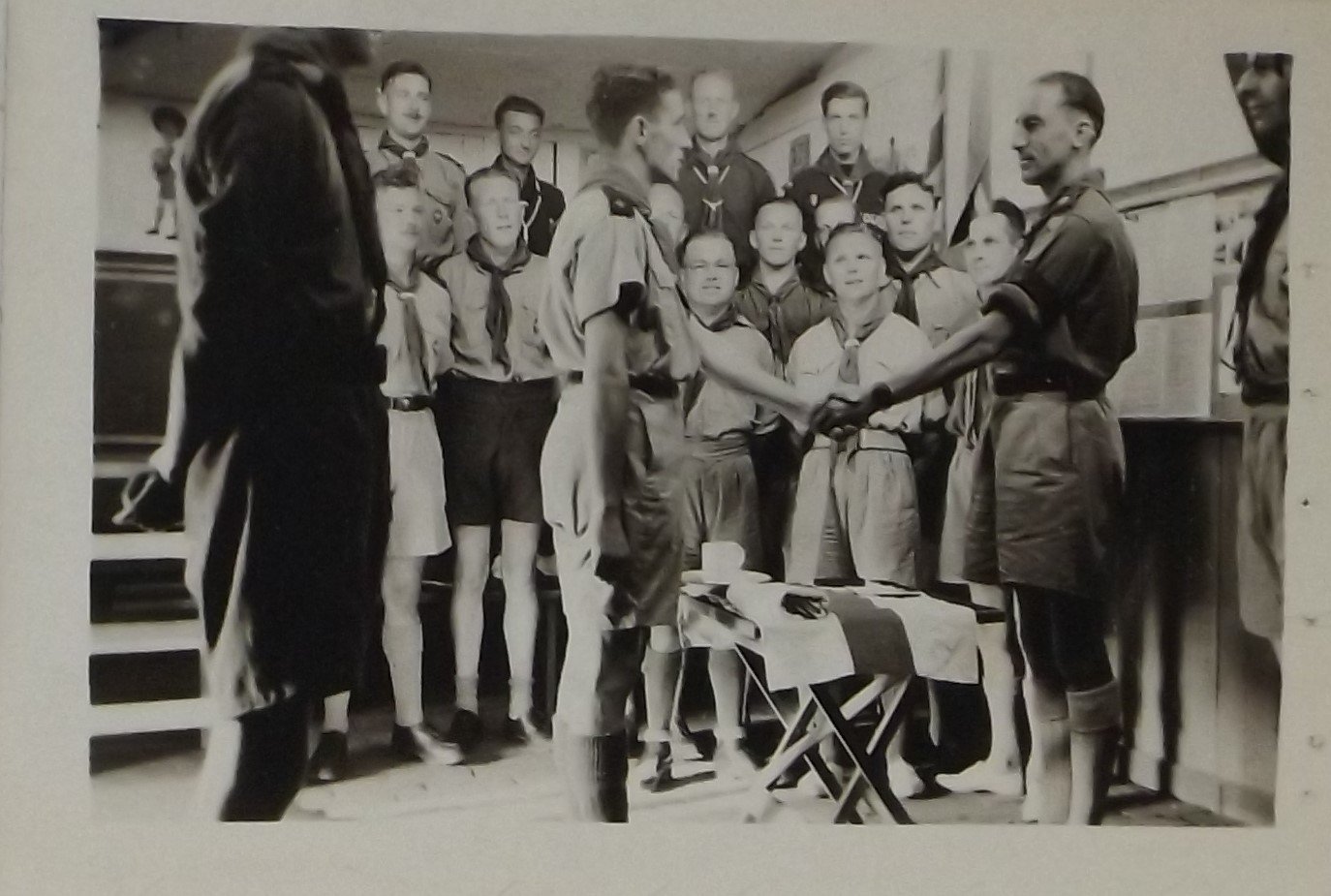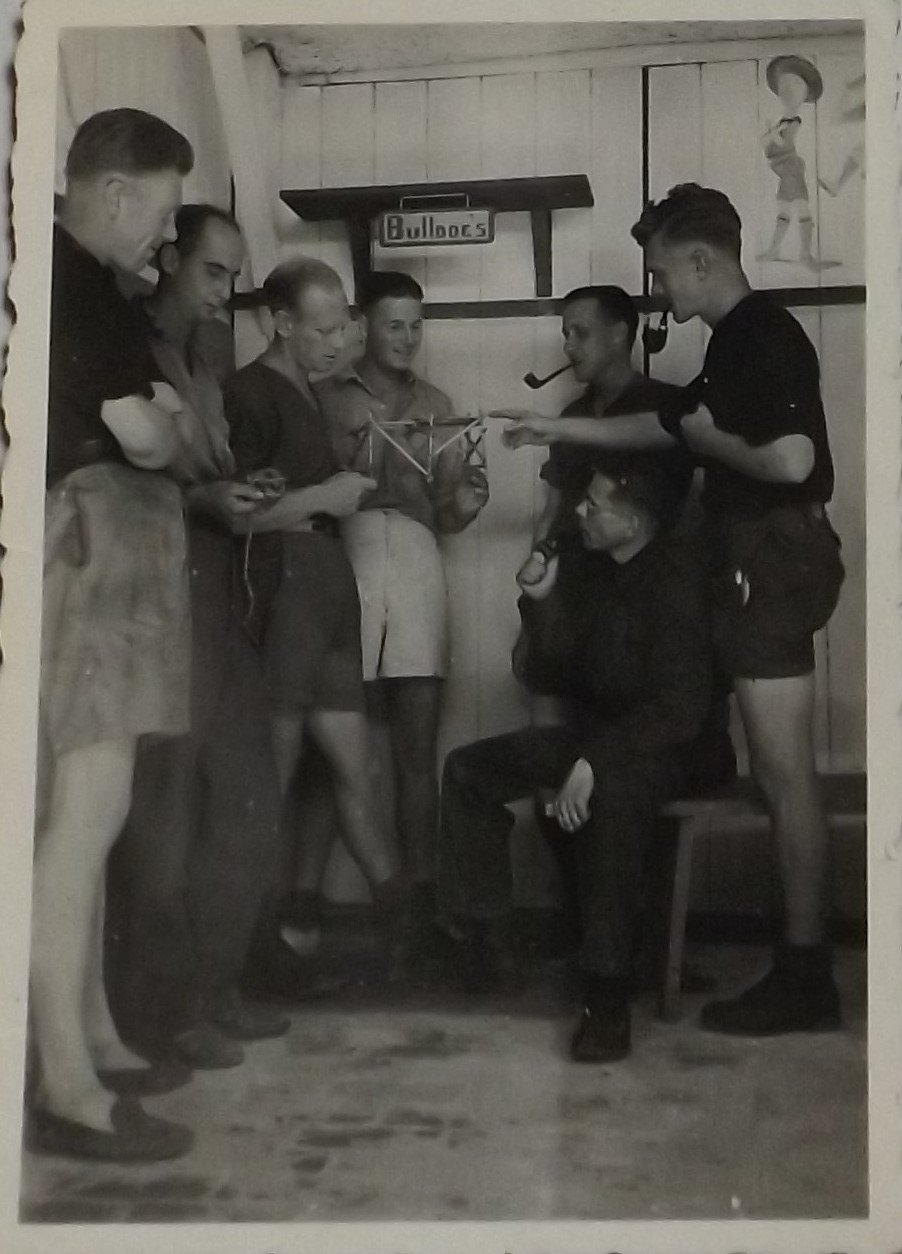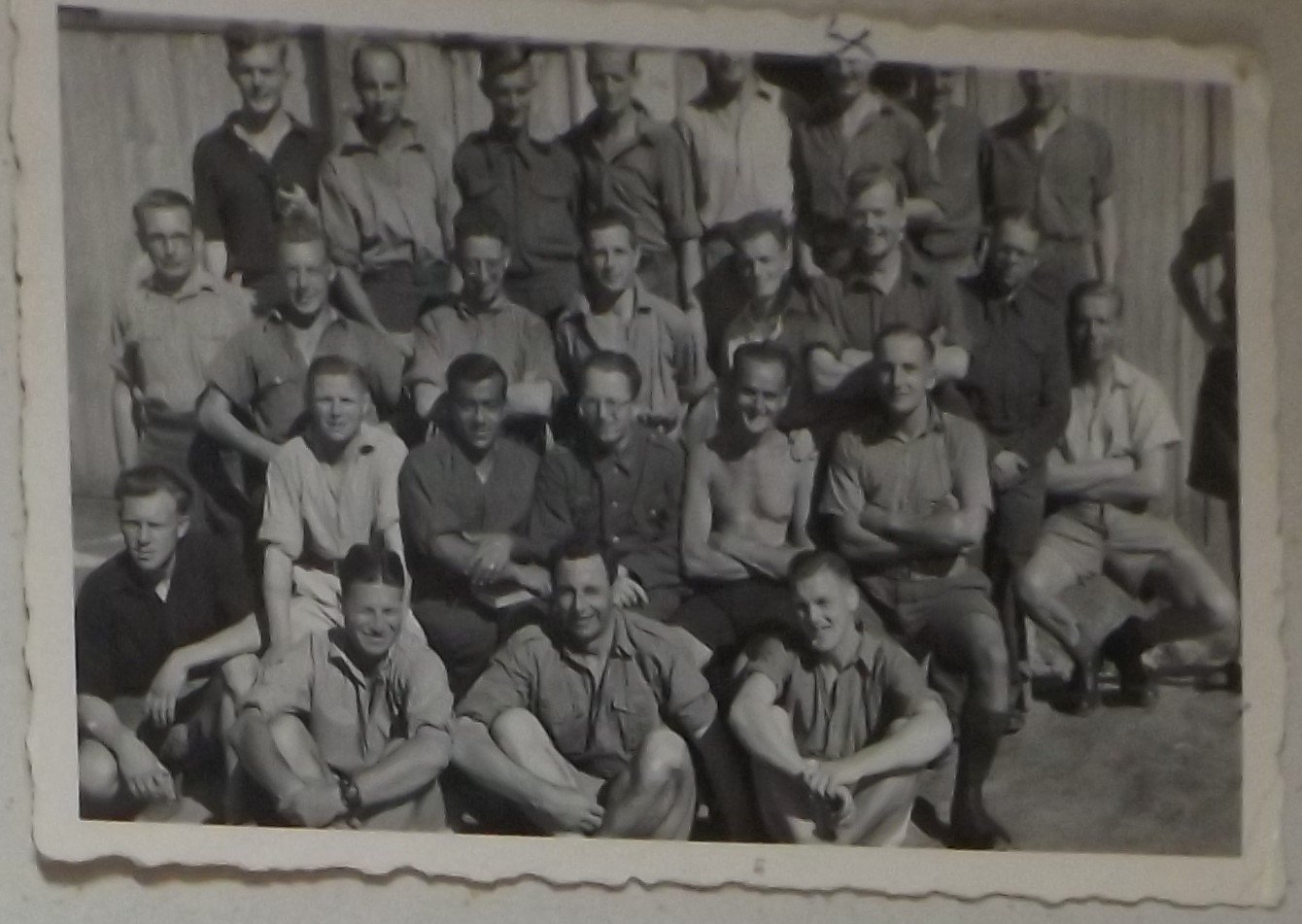
The Second World War resulted in the deaths of around 85 million people. Additionally, tens of millions more people were displaced. However, amid all the carnage people demonstrated remarkable courage, fortitude, compassion, mercy and sacrifice. We would like to honour and celebrate all of those people. In the War Years Blog, we examine the extraordinary experiences of individual service personnel. We also review military history books, events, and museums. And we look at the history of unique World War Two artefacts, medals, and anything else of interest.
John Thorne, British Prisoner of War: Escape, Camp Life and Liberation
Cpl. John Thorne joined the Territorial Army in 1939. By 27 May 1940, John was a prisoner of war (PoW) and headed for a series of camps in Poland and Germany. John would escape, only to be recaptured. Eventually, John was sent to Stalag 383 where he would remain until April 1945. This is his story.
John Thorne joined the Territorial Army in 1939. By 27 May 1940, John was a prisoner of war and headed for a series of camps in Poland and Germany. John would escape, only to be recaptured. Eventually, John was sent to Stalag 383 where he would remain until April 1945. A member of the Scout Movement in civilian life, John was a founding member of the camp’s Richard Coeur-de-Lion, Rover Scout Crew. When the camp was evacuated by the Germans in April 1945, John and some of his comrades escaped once again. However, John’s bid for freedom and journey home did not pass without incident. This is his story.
John in uniform, probably taken in 1939 or 1940 before his deployment with the 5th Buffs to France.
April 1939
John joined the Territorial Army (TA), the 4th/5th Battalion, Royal East Kent Regiment (the Buffs). The 5th Battalion was reformed in 1939 as a 2nd Line duplicate of the 4th Battalion when the Territorial Army was doubled in size. Initially, the 5th Buffs was assigned to the 37th Infantry Brigade, part of the 12th (Eastern) Infantry Division, which was a 2nd Line duplicate of the 44th (Home Counties) Division. However, on 26 October 1939, it was transferred to the Division's 36th Infantry Brigade in exchange for the 2/6th East Surreys.
The 5th Buffs, along with the 6th and 7th Royal West Kents, remained in the 36th Brigade for the rest of the war. The battalion served with the BEF (British Expeditionary Force) in France in 1940 and fought in the Battle of France and was evacuated at Dunkirk. The 12th Division suffered heavy casualties. Unfortunately, many of the men had only very basic training before embarkation. The Division also received minimal artillery support.1
July 1939
John was promoted to full Corporal at Wannock Camp near Eastbourne.
August 1939
John’s unit was mobilised, and he was officially ‘called up’ for active service.
September 1939
The Second World War starts. John is assigned to guard Dover Priory Station and railway tunnels.
October 1939
John is promoted to acting Lance-Sergeant, Dover Priory Station, second in command (2IC) of the guard.
November 1939
John is sent on a course to the brigade tactical school (junior commanders). He reverts to the rank of Corporal. He passed the course and was recommended for a commission and then re-joined his battalion at Canterbury.
January 1940
John is sent on gas and passive air defence (camouflage and concealment) courses. Again, he is recommended for a commission.
14 April 1940
The brigade is sent to France as part of British Expeditionary Force (BEF).
May 1940
John’s unit was based at Fleury-sur-Andelle near Rouen, Normandy. He gave lectures to troops on gas and passive air defence. He was informed by his battalion commander that he would be sent home to start officer training. He was supposed to report to Aldershot on 6 June 1940.
10 May 1940
Germany invades Holland. John’s battalion is moved to Doullens, a major road intersection between Abbeville and Arras and Amiens and Saint-Pol-sur-Ternoise, making it strategically important. The battalion was based at a Catholic Seminary (boy’s school) and tasked with placing roadblocks across bridges.
20 May 1940
The 5th Buffs covered a frontage of approximately 6.5 miles with three companies forward, from Pommera on the right to La Herliere. The 6th Royal West Kent, on their right, covered the approaches to Doullens. Probably the first sign of impending trouble was a wave of retreating French soldiers who passed through the line held by the Buffs. Next, the 6th Royal West Kent positioned were shelled and machine-gunned. By 12.30hrs German tank and infantry attacks were coming in along the British extended defensive line.
At about 13.00hrs the 5th Buffs were ordered to withdraw. However, it appears that this order never reached the forward companies. According to John’s written testimony, his battalion was attacked and quickly overrun by what he believed to be units of the 6th Panzer Division. According to Gregory Blaxland, the 6th Panzer Division hit the 6th Royal West Kent at Doullens while the 8th Panzer Division struck the 5th Buffs and 70th Brigade. The speed and tempo of the German advance simply could not be matched by the French and British response.
The 5th Buffs 6.5-mile defensive line, Doullens, on N25 main road, Northern France, map not to scale.
Those men who avoided immediate capture by the Germans hid in a cabbage field near a train station, and then started marching south towards Amiens. The remnants of the 5th Buffs and 6th Royal West Kent fell back on the Somme in small groups.2
During the brief fighting at La Herliere, Arras Railhead, John mentioned the brave and defiant actions of Private John Arthur Lungley (Service Number: 6584460), B Company, 5th Battalion, The Buffs. Lungley refused to surrender and kept firing his Bren light machine gun until the Germans brought up a tank to deal with him. Lungley is buried in La Herliere Communal Cemetery, France.3
Initially, Lungley was buried in the hole from which he fought. The French villagers, in defiance of the Germans, would lay fresh flowers on his grave every night. When the villagers decided to rebury Lungley in the local cemetery, the event caused such unrest, the Germans stopped the ceremony. Instead, he was quietly reburied at night but the villagers never forgot his stubborn defiance or his sacrifice.4
John’s personal notes, Monday 20 May 1940
We moved out of the seminary in Doullens just after dawn and were taken by company trucks to Le Brey Saute. The company commander, Captain Hart and his second in command (2IC) Captain Rawlins gathered the NCOs (Non-Commissioned Officers) and took us forward to inspect the ground ahead for good concealment and arcs of fire. Dispositions having been decided, the company moved forward by platoons and sections and settled into their positions by 09.30hrs.
Officially we had been told that a few AFVs (armoured fighting vehicles) had broken through on our front. In fact, it was the spearhead of 6th Panzer Division. The enemy column advanced up the road toward B Company at around lunchtime, when many of the men were in the rear area visiting the ration truck.
The platoon .55 calibre Boyes anti-tank rifle was manned by No. 1 Section, who opened fire. This gunfire stopped the enemy lead vehicles. After just three rounds had been fired the order was given by B Company commander for all those manning Brens (Bren light machine gun) and ATRs (anti-tank rifles) to retire to the nearby train station, where trucks were waiting to evacuate us.
On arrival at the train station, the Germans brought a heavy machine gun into play, sweeping the station forecourt, where our trucks were situated. Captains Hart and Rawlins were trying to organise a defense of the station. Under heavy fire, I received permission to get boxes of ammunition off the trucks. Shortly after returning to the company, Captain Hart gave the order, ‘Every man for himself.’ At this point it became obvious many of us would become prisoners of war (PoWs). I decided to try and get away and contact one of the other companies. I managed to get through a barbed-wire fence and across a railway embankment without being spotted by the Germans.
Crawling into a cabbage field, John came across Captains Hart and Rawlins and several NCOs from the company who had also evaded capture. They watched while the Germans used the company’s own trucks as prisoner transport. The group of escapees moved west until they came across a road filled with a constant flow of German vehicles. Hidden at the roadside, the group waited about an hour for a break in the traffic and eventually decided to change direction and move south and try to reach the Maginot Line.
Tuesday 21 May 1940
John’s group of fourteen men moved south across-country. They were provisioned by the generosity of local French inhabitants. Captain Hart was able to draw up a route of march for the group by copying a map provided by a French villager. The group observed endless columns of German vehicles on all the major roads. Captain Hart’s route would take them south and then southwest to Les Andelys.
Wednesday 22 May 1940
On leaving the village where they had received help, the group moved cross-country once again, avoiding main roads. They crossed a field crisscrossed with tank tracks and discovered the bodies of several dead French soldiers laying in a ditch.
Saturday 25 May 1940
The men became separated into two groups while crossing a road during a brief gap in the German traffic. The two groups were never reunited.
Sunday 26 May 1940
John’s group moved toward the river Somme. German artillery had the far bank of the river under fire with shells passing over the heads of the men.
Monday 27 May 1940
John’s group decided to try and cross the river to reach the Allied side. However, the group were surprised by a German sentry and taken prisoner. The group was transported to the German company headquarters, where they gave their names, ranks and serial numbers. Captain Hart was separated from the other ranks. The group was moved by truck to Albert. Next, they were taken to a French aircraft factory and put under guard outside one of the hangers. John recalled how the group of British prisoners became an object of curiosity to passing German troops.
In general, the Germans were either friendly or indifferent to the British servicemen. One German soldier (sometimes referred to as a Landser) stopped to chat with the group in English, and even shared his rations with them. At around 14.00hrs the group was transported toward Bapaume. At about 17.30hrs the group was moved by lorry to Cambrai, where they spent the night at a barracks, sleeping outside on the parade square.
Map of the Principle British and Dominion prisoner of war camps in Europe, 1944,
British Red Cross, Museum & Archives.
Tuesday 28 May 1940
John’s group were taken to Charleville on the river Meuse. Later, they were driven to Bitburg, north of Trier, where they were forced to camp in the open for five days.
Monday 3 June 1940
The prisoners were taken to a railway siding and loaded onto cattle trucks. John was appointed the NCO in charge of his truck, which was overcrowded with around 70 men. John believed the cattle trucks should have accommodated no more than 40 men. From Bitburg the train took them northeast to Koblenz, north to Bonn, Cologne, Dusseldorf, Duisburg, Essen, east to Kassel, northeast to Magdeburg, Berlin, east to Poznan, and finally northeast to Thorn (Torun), Poland. John simply described the journey as long and uncomfortable.
The prisoners were held at Stalag XX-A (Fort 12, Camp 13) until sent to work in Danzig on 25 June 1940.5
Notification that John was interned as a prisoner of war, June 1940.
25 June – 25 August 1940 – Danzig (Gdańsk)
John was rather vague in his description of the camp at Danzig. Using information on the Forces War Records website, John was probably moved to Stalag XX-B Marienburg, Danzig (now Malbork Poland). Originally built during the First World War, the camp was in a poor condition by the time British, Poles and Serbs were held there in 1940. He does say the camp was built on a hillside overlooking the harbour.6
During the second week at the camp, John became friends with Ted Lancaster, Bert Johnson (Sherwood Foresters) captured in Norway, Lance-Corporal Bill Bailey (King's Own Yorkshire Light Infantry) also taken in Norway and Sergeant Bill (Darkie) Jones (Royal Signals) captured in France. Together, John and his new group of friends planned to escape from the camp.
The escape was scheduled for 25 August 1940. The men were provisioned by the camp’s escape committee. Having cut a hole in the perimeter fence, the group slipped out of the camp. The poor upkeep of the camp might have made the group’s escape easier. They climbed up a slope covered with undergrowth and emerged in what appeared to be a public park with many people enjoying a Sunday stroll. The men remained hidden in the undergrowth until dark. Ted had managed to keep a compass hidden on his person. They spent the next few days moving at night and laying up during the day.
29 August 1940
The escapees passed out of the Free State of Danzig. Next day they turned east towards the Russian frontier.
5 September 1940
The group reached the banks of the River Vistula just before midnight but it was too wide to swim across. They found a small rowing boat with just a single oar, and managed to cross the fast-flowing river, which John estimated was about a mile distance.
7 September 1940
Moving along the back of a row of houses, a German policemen apprehended the group at gunpoint. The group had allowed themselves to be seen by several civilians during the previous days. Additionally, just before their capture, two of the group had stopped to ask a resident of the village for cigarettes. The men might not have realised it at the time but around 95 percent of the population of the Free State of Danzig were German, not Polish, and so likely to inform the authorities about them.
On re-capture, the group was transported by truck to a German military prison before being sent back to Danzig by rail. The journey took around three and a half hours by train. It had taken the men 14-days to cover the same distance on foot. To add insult to injury while at Stalag XXA, Camp 13, John and many other prisoners contracted lice.
September 1940 – April 1941 - Stalag XX-A (Thorn/Torun)
On their return to Stalag XXA, the escapees were first kept together in a cell, separated from the other prisoners, for about three weeks. As a punishment for their escape each man would be kept in isolation for 68-days. However, before the punishment was carried out, John was taken ill with suspected Diphtheria (a serious bacterial infection which can cause breathing problems, heart failure and death). He was sent to Fort 14, the camp hospital, and confined there for four weeks. On discharge from hospital, John was sent to Camp 13 where he was placed in a large barracks with hundreds of men, all sleeping in cramped three-tiered bunks.
Suddenly, without warning, John and about 100 other prisoners, all escapees, were transferred by rail and then road to Stalag XI-B Fallingbostel (work camp).
April – July 1941 - Stalag XI-B Fallingbostel (work camp)
Stalag XI-B was one of the Wehrmacht's largest prisoners of war (PoW) camps, holding up to 95,000 prisoners from various countries. In fact, the camp was a complex of small camps spread over many square miles. Stalag XI-C was part of this complex but is better known today as the infamous Bergen-Belsen. The new arrivals at the camp showered, had their heads shaved and uniforms disinfected. John wrote that the camp was clean and well kept. The British prisoners were quartered with a group of French junior officers. The two groups immediately started to plan an escape. However, John’s group were separated from the Frenchmen a few days later and assigned to work parties.
John’s work party was given the task of laying pipes for an agricultural irrigation system. Over a period of a few weeks several men took opportunities to escape. However, most of these escape attempts were spur of the moment decisions and poorly planned.
May – June 1941 – Stalag XI-B - Lüneburg Heath, north of the camp
As John’s work group received no food from their German captors, they decided to go on strike. The guards threatened to shoot the prisoners if they did not go back to work. After a tense standoff between the two groups, the prisoners finally returned to work. As a punishment for refusing to work, John’s group were confined to their quarters without food for five days. It later emerged that the reason the Germans had not fed John’s work party the day of the strike was because it was the Whitson holiday. The guards had planned to return the work party to the camp early and allow the men a half-day holiday. Instead, on release from their confinement, John’s group were immediately transferred out of the camp and sent back to Poland.
Stalag XXI-A, Schildberg, Posen
On arrival at the new camp, John found many of the prisoners were recovering from wounds and some were awaiting repatriation to their home countries. After a few weeks, John and his comrades were assigned to a work party but discovered that it was war work, which was a violation of the Geneva Convention. Naturally, the British refused to work. Once again, the group was threatened with loaded rifles by the German guards but this time they did not back down. Instead, the group was returned to the camp.
July 1942 – April 1945 – Stalag XXI-A – Oflag III-C later renamed Stalag 383, Hohenfels, Upper Bavaria.
The camp comprised 400 detached accommodation huts, each typically housing 14 men. More were built towards the end of the war as prisoners were moved in from other camps as the Russian front advanced from the east. According to John’s testimony, when the British group arrived at the camp there was around 3,000 prisoners including RAF aircrews. When the camp was evacuated in April 1945 the number of inmates had grown to around 18,000 Allied personnel including Americans, Canadians, ANZACs, South Africans, Palestinians, and men from many other commonwealth nations.
Midge Gillies described Stalag 383 as a drab, miserable shanty town designed specifically to hold Allied NCOs who refused to work. The prisoners retained a great deal of autonomy in the organisation and running of the camp. A German censor at the camp wrote that the British prisoners did not give a damn who owned the camp, they just ran it how they liked – and patronised everybody. One of the PoWs said that the guards assumed the status of attendants at a holiday camp. In truth, the prison was no holiday camp for the inmates.
Mental Stress
The mental stress of incarceration showed itself in different ways in British prisoners of war. The camp inmates of Stalag 383 occasionally went ‘Stalag happy’ and performed the most bizarre and elaborate charades to occupy and entertain one another. Strange behaviours demonstrated by groups and individual inmates included holding a full-scale fox hunt through the camp and the setting up of an imaginary railway service to England. Inmates dressed as the Emperor Napoleon, Admiral Lord Nelson, and a tribe of North American Indians. One prisoner regularly walked an imaginary dog, another herded imaginary sheep while a third rode his imaginary motorcycle around the camp.
The Commandant of Stalag 383 became so concerned with the mental health of the prisoners that he suggested to the Senior British Officer of the camp that some men could take walks under parole outside the camp to alleviate the symptoms of stress.7
Food Scarcity
In 1944, there were about 90,000 British prisoners of war held in Germany or camps in occupied territories. In contravention of the Geneva Convention, which required the Germans to feed prisoners a basic, balanced diet, the men never received proper rations from their captors. The British Red Cross, St. John War Organisation, YMCA, and International Red Cross worked tirelessly to ensure prisoners were able to receive food parcels from home. Instead of luxuries, food parcels became necessities, supplementing the prisoners’ poor, unbalanced diet. However, the Germans were meticulous in the delivery of Red Cross and similar parcels, making them a top priority for the transport system.
Over the course of the Second World War, the British Red Cross sent around twenty million food parcels from the UK to British Prisoners of War scattered around camps in Nazi-occupied Europe and in the Far East. Around 163,000 parcels were packed each week except at the start and toward the end of the war.8
As well as food, the British Red Cross and St. John War Organisation sent clothing, books, musical instruments, games, and many other sundry items to British captives. It’s clear that a certain amount of pilfering was done by the Germans, nevertheless, most items did eventually reach their intended destination. Naturally, lack of food, over-crowded accommodation, inclement weather conditions, and disease all took their toll on the prisoners’ health and mental well-being.9
Prisoner of war food parcel, 1939-1945, British Red Cross, Museum & Archives.
The Rover Scouts
On 15 September 1942 the first British NCOs arrived at Oflag III-C. The British were placed in the camp because they were unwilling to work for the Germans. On arrival at the camp prisoners tended to form into groups based on nationality, branch of service or some common interest. One of the first groups to form in the camp was of people connected with the Scout Movement in civilian life.
In October 1942, a group of British and commonwealth prisoners decided to form an official Rover Scout Crew, which they named Richard Coeur-de-Lion (Richard the Lion Heart). The Scout Leader was Australian warrant officer Ivan C. Stevens, better known as Steve. John was appointed Quartermaster. The crew was divided into three patrols: the Bulldogs, Nomads and Owls. An old harness room in one of the disused stable blocks became the scout Den and was later used as the camp school room and library. As suitably quiet accommodation for study was extremely limited in the camp, the Den was opened as a ‘quiet room’ for those seeking solitude. A member of the scout crew would always be in attendance when the Den was open.
The scout crew took on many of the mundane chores necessary to keep the camp functioning such as collecting firewood. The scouts organised numerous activities to keep its members and other prisoners busy from debating societies and amateur dramatics to sports and various self-improvement classes. First Aid classes were taught by the scouts until a St. John Ambulance Brigade was formed in the camp. The Brigade performed medical duties at all camp football matches and theatre performances. Members of the scout crew took an active role in the many theatrical productions held at the camp’s National Theatre. The scout crew organised social events such as the annual Christmas party. Holidays like Christmas and New Year could be particularly difficult psychologically for prisoners. Depression could settle on a man; its symptoms so well recognised the prisoners called it ‘barbed-wire disease’.10
John (marked with an X) during the Scouts last Christmas Party in Stalag 383. John in the Scout Den with some of the crew, Christmas 1944.
Click on images to enlarge
Camp Universities
Francis Newman was the first British serviceman to pass a professional examination in a prison camp during the Second World War. For many men, captivity represented an opportunity to gain an education and qualifications that would have otherwise been denied to them in ordinary life.11 Stalag 383, John said the camp contained so many talented people with nothing but time on their hands that a Warrant Officer (WO) from the Royal Army Educational Corps started a Stalag University. The University taught a wide range of subjects and attracted thousands of students.
The Educational Book Section of the British Red Cross PoW Department was responsible for collecting and dispatching books for study to men in the camps. By May 1942 the Educational Book Section had received 15,355 requests for books and study aids and had arranged for over 69,000 educational books and 3,542 study aids to be sent to the camps, regardless of a wartime shortage of paper. The British Red Cross approved 6,091 different exam papers from 136 different examining bodies from Cambridge University to the Beekeepers Association. The Red Cross also sent rulers, mathematical instruments, drawing boards and chalk. Medical students were sent skeletons and other anatomical specimens to help them pass practical biology exams. The Germans would provide tables and chairs for examination rooms. The Educational Section sent 17,000 exam papers to students who sat around 11,000 exams with an average pass rate of 78.5 percent.12
A collection of photos of a Stalag 383 ‘National Theatre’ production of Rope, winter 1944.
September 1942 – April 1945
As the inmates refused to work for the Germans, they had plenty of time to kill. Subsequently, numerous sports were played in the camp. The inmates even managed to transform a large concrete water tank known as the Fire Pool (which provided a central source of water in the event a fire broke out within the camp) into a serviceable swimming pool. John remarked how during hot days the swimming pool was often crowded with inmates until lights-out. Many aquatic sports competitions were held in the pool and each of the fourteen companies fielded a water polo team. John also helped the camp escape committee but gives no details of his activities in his testimony.
Using clandestine radios, the inmates were able to monitor news broadcasts and follow the Allies advance into Germany during the last months of the war. In early April 1945, the prisoners were informed the camp was to be evacuated.
John, standing, right, probably taken in Stalag 383 as all subjects are NCOs.
12 April 1945 – Stalag 383
John wrote that on 12 April 1945 the Red Cross white ladies (army lorries painted white and driven by British military personnel (PoWs) accompanied by German guards and a Red Cross representative) arrived at the camp. Red Cross parcels were handed out, one between four men. Next, the prisoners were moved out of the camp and onto a road. John said that whether the men were march-fit, sick, or disabled, it was all the same to the German doctors. Everyone who could be found was forcibly evacuated from the camp. Apparently, many inmates concealed themselves in various hiding places within the camp to avoid the exodus. There was no motor transport for the inmates and by nightfall men were dropping out along the line of march. At first, John explained, the guards would try to rouse the small groups and get them marching again. But later, no one from the camp administration came along when John and a small group of his comrades dropped out for a rest. They took this opportunity to slip away from the forced march.
13 April 1945
Early the next morning John and his friends cleaned themselves up and then moved off in regulation fashion. John recalled that they looked quite smart as they marched along. However, the group were stopped by a German Field Police (Feldgendarmerie) unit looking for deserters. The Feldgendarmerie turned the British over to a small group of German truck drivers who had lost their vehicles when they had been attacked by Allied fighter-bombers. Together, the little mixed group of Germans and British NCOs marched about ten miles to Hohenberg (unfortunately John is a little vague about the exact location but is probably the town between Stuttgart and Nuremberg). The British were handed over to the civil authorities in Hohenberg, where they were given rations and bedding, and remained there for a few days.
14 April 1945
John wrote that at about midday on 14 April, a French soldier called Rene joined their group. He said he had been picked up outside Regensberg, which is east of Hohenberg, after he had escaped from a PoW camp. John remarked that he seemed pleasant enough and spoke good English.
15 April 1945
John and his comrades were put to work around the town but were not closely supervised. During the afternoon of 15 April, a German military motorcycle came racing through the town pursued by an Allied rocket-firing Typhoon aircraft. To try and evade its pursuer, the motorcycle went over a humpbacked bridge at speed and then turned into a large barn that stood beside the road. At the same moment, the Typhoon pilot fired a salvo of rockets. The rider and passenger either jumped or were thrown clear as the motorcycle crashed into the barn. In the next moment, the rockets hit the barn and it exploded. Unfortunately, the barn housed cows and horses. John explained how the nearby towns people and PoWs rushed to the scene and were able to save about seven or eight of the 15 animals trapped in the inferno.
16 April 1945
The next day, after the episode with the Typhoon and motorcycle, the local Bürgermeister (mayor or chief magistrate) sent for the group of PoWs. The Bürgermeister was concerned that the town’s women would be raped when American troops arrived to occupy the town and asked the men to intercede on the town’s behalf. This fear that the town’s women would be raped was probably due to propaganda and stories of widespread rapes and killings of German civilians by Russian troops in the east of the country.
17 April 1945
John recalled that around breakfast time he heard a commotion downstairs and on investigation found Stan “NAAFI” Henson in a car with a group of chaps, all armed to the teeth, from Stalag 383. Henson informed John that the prison camp had been liberated by the Americans. The German doctor who had insisted that all the sick and disabled prisoners be evacuated from the camp had been shot dead. Henson’s group left John and his comrades with arms and ammunition and told them to roundup any German soldiers left in the town. Next, John says they went to see the Bürgermeister and told him that the town’s folk should hang white bed linen from upstairs windows and public buildings to signify surrender. The British NCOs then went around confiscating weapons from those German troops who remained in the area.
Just after lunchtime an American Jeep arrived in the town square. John and his comrades made themselves known to the American troops. The jeep was the point detail or reconnaissance vehicle for the approaching 4th Armoured Division. An American Private asked John if he would sell him the Luger pistol (P08) he was carrying. These were highly prized souvenirs amonst American troops. John said the Private was overjoyed when he simply handed the pistol over as a gift. As elements of the armoured division started to rumble through the town, John and his comrades sat beside the road while American troops tossed them cartons of cigarettes, C and K-rations as they passed.
At dusk, the group was transported by the Americans to a farmhouse some miles away. The German farmer and his family were relocated to the barn.
18 April 1945
About lunchtime John’s group moved to an American Army encampment. Next, the group moved to Nürnberg (Nuremberg) and were informed that they would be handed over to AMGOT (Allied Military Government of Occupied Territories). AMGOT wanted to move John and his comrades back toward Stalag 383. This arrangement did not suit John, who wanted to move forward, not back. So, John and Rene decided to make their own way home. First, they got a ride in an American Army truck heading northward. However, the truck dropped them in the middle of nowhere. They walked to the nearest village, which was occupied by the Americans. They were taken into custody and interrogated by an American intelligence officer. As John had letters from home and some official documents on his person that substantiated his story, he was eventually released from custody. John was sent to the guardroom where the Military Police made him welcome, but Rene was not released. The commander of the guard kept referring to John’s ‘kraut’ friend (meaning Rene).
Next morning, driving out of the village, John passed a large PoW stockade and one of the prisoners was Rene. John was told that Rene was not a Frenchman, but a German Obergefreiter from a Panzer Grenadier Regiment stationed near Regensburg. When his unit’s camp was about to be overrun by the Americans, Rene had fled and hidden in a nearby forest. Later, he had murdered a French PoW and stolen his identity. John never learned the German soldier’s real name or his fate.
19 April 1945
John was taken to a US airfield where he waited for a flight home. A group of American servicemen took him under their wing and entertained him. While at the airfield, John said he watched the film White Christmas, but he was mistaken as the movie was not released until 1954. He probably watched the film Holiday Inn (1942), which featured Bing Crosby singing the song White Christmas.
20 April 1945
After waiting around all morning on the runway, John and two British officers were told they would be put on a flight to Ghent, Belgium, but due to bad weather the flight was re-routed to Paris, France. The flight landed about 17.00hrs and they were taken to a US Rest Centre nearby.
22 April 1945
Finally, John got a ride on an RAF Transport Command, Handley Page Hampden aircraft to RAF Croydon. Next, John went to Chalfont Saint Giles and then to Worcester. Two days later, he was on a train home. When John left for France in 1940, he weighed 12 stone 8oz. On his return to England, he weighed just 8 stone 3oz, but he was home at last.
A telegram announcing John’s arrival home, which reads: ‘John Stafford arrived yesterday evening without a rag to his back or a penny in pocket. Mother naturally shocked at his appearance but getting over it. Charles.’
Primary sources
John Thorne’s family provided a range of official documents, maps, books, and photograph albums plus 50-pages of handwritten testimony about his wartime experiences and his life in various prisoner of war camps.
Secondary sources
1. Buffs (Royal East Kent Regiment), see: https://en.wikipedia.org/wiki/Buffs_(Royal_East_Kent_Regiment)
2. Destination Dunkirk: The Story of Gort’s Army, Gregory Blaxland, William Kimber & Co. Ltd., 1973, pp. 121-129
3. Commonwealth War Graves: https://www.cwgc.org/find-records/find-war-dead/casualty-details/2279541/john-arthur-lungley/
4. Destination Dunkirk, Blaxland, p. 131
5. Stalag XXA https://en.wikipedia.org/wiki/Stalag_XX-A and Torun Fortress https://en.wikipedia.org/wiki/Toru%C5%84_Fortress
6. Stalag XX-B Marienburg, Danzig https://www.forces-war-records.co.uk/european-camps-british-commonwealth-prisoners-of-war-1939-45
7. The Barbed-Wire University: The Real Lives of Allied Prisoners of War in the Second World War, Midge Gillies, Aurum Press Ltd, London, 2011, pp. 76-83
8. British Red Cross, Museum and Archive, Prisoner of War Food Parcel webpage, accessed 15 May 2022 https://museumandarchives.redcross.org.uk/objects/8944
9. Prisoner of War: The Story of British Prisoners held by the Enemy, Noel Barber, George G. Harrap & Co Ltd, London, 1944, pp. 13-17
10. Glowing Embers, R. Philip Smith, Jarrold and Sons Ltd, Norwich, 1946, pp. 7-19
11. Prisoner of War, Barber, pp. 40-49
12. The Barbed-Wire University, Gillies, pp. 271-288
Additional resources
The Red Cross Museum archive https://museumandarchives.redcross.org.uk/objects/29269
The Museum of St. John https://museumstjohn.org.uk/st-john-during-the-second-world-war/
Stalag 383 Bavaria: A History of the Camp, the Escapes and the Liberation, Stephen Wynn, Pen & Sword Military, 2021.
Marketing The Tank Museum
The Tank Museum, situated in Bovington Camp, Dorset, is great example of how the modern museum must change to succeed. The Tank Museum’s marketing success has taken time and lots of moving parts. The engine of this growth and innovation has been the museum’s partnership with Wargaming.net, the award-winning developers of the massive multiplayer online game World of Tanks.
UK tourism is big business. According to VisitBritain.org nearly 4 million people currently work in the sector and it’s expected to generate £257.4 billion by 2025 (1). Thousands of attractions from castles and galleries to wildlife parks compete to attract domestic and overseas visitors. There are 2,500 museums alone in the UK (2). What is more, visitor expectations have grown exponentially. Visitors demand more bang for their buck, and will holler loudly on social media and review sites if they don’t get it.
Museum on a Mission
Today’s museums need clarity of purpose, specialist skills and marketing teams to win the war of visitor attraction. The Tank Museum, situated in Bovington Camp, Dorset, is great example of how the modern museum must change to succeed. The museum has a clearly stated purpose, "To tell the story of tanks and the people who serve with them (3)". Its mission can be summarised as “to conserve, develop and interpret the national collection of tanks and armoured fighting vehicles to educate and inspire people (4).”
The museum started out as little more than a shed that housed a small number of important military vehicles from the First World War. In 1947, the museum opened to the public. By 1981, it had around 120 armoured vehicles in its collection. The arrival of a new curator saw a period of expansion, as the museum refocused its efforts on vehicle restoration and conversation. In the noughties, a second period of expansion saw the restoration of Tiger 131, introduction of the annual Tankfest flagship event, an upgraded arena, new museum entrance, display hall and Vehicle Conversation Centre. Today, The Tank Museum holds the world’s largest collection of tanks, attracts over 200,000 visitors annually, and plays an important educational role (5).
Wargaming.net
The Tank Museum’s marketing success has taken time and lots of moving parts. The engine of this growth and innovation has been the museum’s partnership with Wargaming.net, the award-winning developers of the massive multiplayer online game World of Tanks. Since 2011, Wargaming.net has sponsored The Tank Museum’s main summer event, Tankfest. In 2013, they sponsored the creation of The Tank Museum’s state-of-the-art Education Centre. In 2014, Wargaming.net sponsored the ‘Fury’ exhibition, which celebrated the museum’s involvement in the making of David Ayer’s war movie (6).
At Tankfest 2015, Google partnered with Wargaming.net and The Tank Museum to create the UK’s first virtual reality (VR) military museum experience (7). In recent years, the museum’s Vehicle Conservation Centre has become the gaming hub of Tankfest with an array of activities that are streamed live across various platforms such as Facebook, Instagram and YouTube. Wargaming.net offers gamers special premium versions of classic tanks such as The Tank Museum’s ‘Fury’ Sherman for limited periods. Opened in April 2017, World of Tanks supported the Tiger Collection exhibition, which brought together every member of the Tiger tank family in one display for the first time. Wargaming.net also supplied a virtual reality Sturmtiger, when arrangements for the loan exhibit fell through (8). The company has also been instrumental in bringing guest vehicles, such as the Char B1 medium tank and “Bretagne” Panther, from the Musée des Blindés (French Tank Museum), to appear at Tankfest.
Meeting Audience Demand
In a survey by the American Alliance of Museums, millennials (those born between 1980s and early 2000s) said that traditional museums were “static places for exhibiting things”. The survey found that millennials want interactive, immersive and participatory activities from museums (9). Today, technology makes it possible to create these interactive, immersive experiences. However, most museums lack the funds and expertise to harness technology themselves. Instead, they need like-minded corporate partners and sponsors such as Wargaming.net and Google.
A New Reality
Sponsorship works best when the parties involved share similar values, target the same audiences and have closely aligned objectives. Wargaming.net have created a variety of educational activities, from dedicated websites, augmented and virtual reality experiences to education centres. One of the game developer’s stated aims is “to promote an interest in history and show that education can be an engaging and even enthralling experience.” The virtual recreation of the Sturmtiger for The Tank Museum’s Tiger Collection exhibition is just one example of how Wargaming.net is working with military museums across the world to create amazing, interactive “mixed reality” experiences. Together, institutions like The Tank Museum and companies like Wargaming.net are changing visitor experiences from something static and one-dimensional into something interactive and immersive. What’s more, the experience is no longer confined by geography, physical exhibition space or artefact availability. The digital world knows no bounds. Of course, the ability to create more engaging, memorable visitor experiences delivers commercial benefits for the museum and its sponsors from brand building and increased visitor numbers to selling more premium features on your game platform and merchandising. It’s a win-win for everyone.
Education
In 2017, 6,924 schoolchildren and accompanying adults visited The Tank Museum as part of formal education programmes, an increase of over 1,500 from the previous year. The museum runs activities and events that relate to science, technology, engineering, arts and maths (STEAM) for primary and secondary schools. It has also developed partnerships with a number of universities. The museum’s educational programmes help anchor the institution within the local community, engage with completely new audiences and preserve the history of armoured warfare for generations to come (10).
The Tiger Workhorse
Today, Tiger 131 is the world’s most famous tank. It is also The Tank Museum’s most popular exhibit. Captured in April 1943, Tiger 131 was inspected by King George VI and Winston Churchill before being shipped to the UK where it went on public display. Next, the tank was subjected to an extended period of testing and evaluation. In 1951, Tiger 131 was sent to The Tank Museum. After a long period as a static exhibit, restoration work started in 1990. By 2003, the tank had been returned to running order, making it the world’s only operational Tiger 1. In 2014, Tiger 131 featured in the Hollywood war movie ‘Fury’. The last time a genuine Tiger tank had appeared in a film was 1950. In 2017, Tiger 131 was centre of attention again when the museum opened its Tiger Collection exhibition. The tank has also appeared in a number of history documentaries. The Tank Museum now runs two dedicated Tiger Day events every year. In 2017, these events attracted 4,500 visitors to the museum. Regular ‘Ride the Tiger’ online auctions and raffle ticket sales generate much needed income for on-going preservation and maintenance work. Tiger 131 merchandising, from t-shirts and mugs to World of Tanks special packages, make sure the vehicle earns its keep (11).
Merchandising
Retail marketing and merchandising has an important role to play at The Tank Museum. Naturally, it encourages secondary spend, money generated over the price of museum entry. Retail marketing also improves the customer experience, increases perceived value and strengthens brand engagement. As part of the museum’s recent makeover, the restaurant, gift shop and product mix of souvenirs have been better aligned with the museum’s brand values, personality, narrative and visual identity.
The Tank Museum gift shop and online store offer a wide selection of branded merchandise from mugs, books, wall art and apparel to model kits (12). In partnership with a number of manufacturers, the museum has created unique souvenirs such as branded versions of the classic board games Monopoly and Cluedo. Shoppers can buy a wide selection of Tiger tank themed items such as Tiger 131 premium lager, COBI Tiger 131 model kits and a reproduction of the Tigerfibel, the original Tiger tank crewmember’s manual. The gift shop’s design, layout and choice of merchandise aims to surprise, delight and extend the visitor experience. The gift shop enables visitors to continue learning about the history of the various exhibits. It also creates an opportunity to transform the one-time visitor into a lifelong ‘Friend of the Museum’.
Overcoming Geography with Social Media
The Tank Museum is Dorset’s highest ranked visitor attraction on TripAdvisor and has won numerous tourism awards. However, the museum’s location in rural Dorset also poses a challenge. It takes the average visitor 2-hours to travel to the museum. To extend its reach and build lasting relationships, The Tank Museum has turned to social media platforms such as Facebook, Twitter and YouTube.
In 2017, the museum’s YouTube subscribers reached 100,000 with over 7 million views of its content. Today, the museum has over 208,000 subscribers with a view count of 32.5 million. YouTube is particularly effective at reaching young men aged between 15 and 25. Traditionally, this is a difficult demographic for organisations within the heritage community to attract. In 2017, The Tank Museum was the most ‘liked’ military museum in the world on Facebook with 300,000 followers. The total reach of the museum’s content through Facebook was over 37 million users for the year. The museum’s Facebook page also integrates with its online store and YouTube channel. Currently, the museum also has 26,500 Twitter followers (13).
According to the online traffic statistics from SimilarWeb, the museum’s website receives around 280,000 visitors annually. 83% of all traffic is direct or from search. Just 8.42% comes from social. However, it’s a different story when you look at the online store analytics. This site receives 100,000 visitors per year. 41% of the site traffic comes from referrals and 11.23% from social media with YouTube being the most effective (14). To increase engagement, promote learning and generate additional income, it makes sense for the museum to experiment and invest in social media. After all, people are naturally passionate about their hobbies and interests. Unlike many organisations, who fail to understand the basic premise of social media, the museum has found that ‘likes’, ‘follows’ and ‘views’ can translate into visitors, supporters and sales.
Clear-Sighted Strategy
Heritage and tourism are highly competitive markets. In order to compete, institutions like The Tank Museum must have clear-sighted, long-term commercial strategies that enable them to pursue their objectives. In order to remain relevant, museums must diversify, adapt and make the most of their assets. Back in 1998, The Tank Museum began to build the infrastructure it would need to succeed in the future. It has expanded its education programme, demonstrations and events. These activities have steadily increased visitor numbers from home and abroad. In order to attract a younger audience, the museum has established an extremely successful on-going partnership with online game developer, Wargaming.net. They have provided much needed funds and technical expertise to build a new Education Centre and pioneering virtual reality experiences. The museum has not been shy about sweating its assets. A restored Tiger 131 is forever in the spotlight. Finally, the museum has used the Internet and social media to overcome the challenge of its rural location to reach new demographics. According to the Charity Commission, The Tank Museum generated an income of £5.8 million in 2017 (15). This money will help ensure the story of the tank and people who serve with them continues to be told, now and in the future.
-END-
Sources:
1. Britain’s visitor economy facts, Visitbritain.org website: https://www.visitbritain.org/visitor-economy-facts
2. The Museum Association website https://www.museumsassociation.org
3. The Tank Museum Limited, Trustees' report and financial statements for the year ended 31 December 2017, Page 2.
4. The Tank Museum Limited, Trustees' report and financial statements for the year ended 31 December 2017, Page 2
5. The Tank Museum website, Museum History page, https://www.tankmuseum.org/about-us/history
6. Wargaming.net website news pages https://worldoftanks.com/en/news/press/wargaming-sponsor-education-center-tank-museum-bovington-england/ and The Tank Museum website news pages https://www.tankmuseum.org/year-news/bovnews53146
7. War History Online website, Wargaming Unveils its First Virtual Reality Tank Battle Reenactment, https://www.warhistoryonline.com/world-war-ii/wargaming-unveils-its-first-virtual-reality-tank-battle-reenactment.html
8. Deep South Media, Tank museum leads with world with augmented reality, Nik Wyness, Head of Marketing, The Tank Museum, webpage: https://www.deepsouthmedia.co.uk/8519-2/
9. American Association of Museums, Demographic Transformation and the Future of Museums report, Elizabeth E. Merritt, founding director. Download a PDF copy of the full report: https://www.aam-us.org/wp-content/uploads/2017/12/Demographic-Change-and-the-Future-of-Museums.pdf
10. The Tank Museum Limited, Trustees' report and financial statements for the year ended 31 December 2017, Page 5.
11. The Tiger Tank website https://blog.tiger-tank.com/
12. The Tank Museum’s online store: https://tankmuseumshop.org
13. The Tank Museum Limited, Trustees' report and financial statements for the year ended 31 December 2017, Page 5.
14. SimilarWeb provides a free online tool that generates real-time website traffic statistics.
15. The Tank Museum Limited, Data for financial year ending 31 December 2017, Charity Commission website: https://beta.charitycommission.gov.uk/charity-details/?regid=1102661&subid=0
Donald A. McCarthy, A Veteran’s Story
In this post, we tell the story of D-Day veteran Donald A. McCarthy, who served with Headquarters Company, First Battalion, 116th Infantry Regiment, 29th Division, and landed on Omaha Beach.
In 1999, I was researching the D-Day landings for a radio project. As part of my research, I was lucky enough to start corresponding with 29er veteran, Donald A. McCarthy. Sadly, Donald passed away in 2017 at the grand age of 93. He lived a full and active life. He was rightly proud of his military service. He was Commander of the 29th Division Association from 1995-96 and made 14 trips back to the Normandy beaches and battlefields. In 2014, he was awarded the French Foreign Legion of Honour. As part of the 75th anniversary of D-Day and battle for Normandy, I thought it worth sharing Donald’s own experience of landing on Omaha Beach as he told it to me.
Training for D-Day
I was a member of Headquarters Company, First Battalion, 116th Infantry, 29th Division. I was drafted in July 1943 after graduating from High School. I completed basic infantry training in Alabama, shipped overseas on the Il de France, assigned to 1BN 116t RCT at Ivybridge, 26 January 1944. The RCT (Regimental Combat Team) began intensive training at the Assault Training Centre, Woolacombe Beach on the North West Coast of Devon, and later in April participated in Exercise Fox at Slapton Sands. We were fortunate to have preceded the horrible debacle of Exercise Tiger of 27th April.
Omaha Beach
Again, I was fortunate to have survived the landings of the third wave at Omaha Beach. Although the flotilla was originally scheduled for Dog Green sector of the beach, the British Coxswain and the entire flotilla of LCAs (Landing Craft Assault) from the SS Empire Javelin (Infantry Landing Ship, Large) were carried in an easterly direction by the tide toward the Dog Red sector and the Moulin Draw.
My LCA had taken on water, was swamped and sank about 200 yards from the low watermark and beach obstacles. Several of us swam in behind bodies and attempted to hide behind the obstacles from machine gun and artillery fire. Although the MG fire was intense, the Germans on the bluff were unable to see us because of smoke from burning grass and buildings blowing east from the Vierville (Vierville-sur-Mer) area. The smoke screen provided an opportunity to run from the water’s edge, and the fear of getting run down from incoming landing craft, and find protection from the high water shingle.
Evacuation
Some of us managed to crawl toward the Vierville Draw and were eventually able to move up the draw and reach our objective, the church in Vierville. We came under fire from our own navy and I was ordered to return to the beach and attempt to contact the US Navy beach master. I was hit by an overhead shell burst in my left leg after finding a radio. The radio caught the brunt of the burst and both my leg and the radio became inoperative. A medic dragged me to a makeshift slit trench near the shingle within 100 yards of the draw. The following morning hundreds of us managed to walk towards the Moulin Draw and most were evacuated on LSTs (Landing Ship, Tank) back to ports in Britain. Some of us recovered and returned to Normandy within three weeks.
Wounded Again
I was able to re-join my company by early July and participate in the battle for St. Lo and Vire. During the attack at Vire, I came under heavy fire in an abandoned garage. The roof collapsed and debris hit my hand and neck. I did not consider my wounds serious until a form of blood poisoning finished my days with the 116th in France.
After several weeks in a General Hospital at Great Malvern, I was assigned to an Infantry Training Centre at Tidworth Barracks. We ran a training facility for Air Force personnel and shipped them to Holland and Germany as infantrymen.
Home
I remained a PFC (Private First Class) throughout my time in the ETO (European Theatre of Operations). In January 1946, I returned home to Boston and enrolled in college. I got married and worked for Bell Systems for 30 years. My work with Bell Systems centred on defence telecommunications with the US Navy including a period in Vietnam between 1967 and 1968. After leaving Bell, I worked for the Chamber of Commerce in Providence, Rhode Island. In 1969, I returned to England, chartered a small sailboat at Gosport, and sailed to Omaha Beach to recapture the event that changed my life. Since then I have returned to Normandy to take part in D-Day anniversary events with many other 29ers.
-END-
Visit the 29th Division Association website to learn more about the unit’s contribution during World War Two. Additional material courtesy of US Department of Veteran Affairs and Back to Normandy website.
D-Day 75: Daks Over Duxford
Watch our highlights video of the IWM Duxford’s Daks Over Duxford event as part of the 75th-anniversary commemorations of the D-Day landing of June 6 1944. The largest collection of Douglas C-47 Skytrain and DC-3 aircraft since World War Two. Ten aircraft flew sticks of paratroops over to Normandy for a mass parachute drop. We have also published 57 photos from the Daks Over Duxford event.
As part of IWM’s D-Day 75th anniversary week, Daks over Duxford told the extraordinary story of D-Day, uniting the greatest number of Douglas C-47 Skytrain and Dakota aircraft in one location since the Second World War. Synonymous with the D-Day Landings, more than 30 'Daks' descended upon IWM Duxford.
Mass parachute jumps and flight displays took place across the museum ahead of the epic cross-channel flight to Normandy on 5 June. On the ground, D-Day-related displays and activities brought the extraordinary story of D-Day to life.
In fact, 21 DC-3s and Douglas C-47s finally went to Normandy, ten of the aircraft carrying sticks of paratroopers for a mass drop as part of the Daks Over Normandy commemorations across the Channel. In reality, 1200 Douglas C-47s were used for D-Day. As well as the Daks, a P-47 Thunderbolt, two Mk 9 Spitfires and two P-51 Mustangs performed aerial displays. There was also a very impressive flypast by a collection of USAF C-130s and V-22 Osprey modern aircraft.

